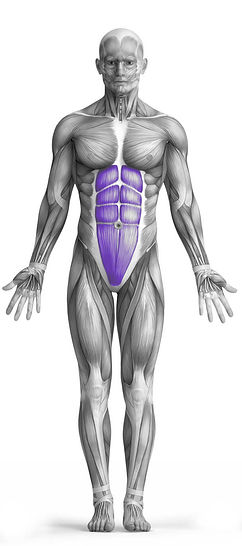Crab Toe-Touch 101 Video Tutorial
0

Exercise Synopsis
Target Muscle Group
Abs
Secondary Targets
Execution
Compound
Force Type
Core
Required Equipment
Bodyweight
Fitness Level
Intermediate
Variations
None
Alternatives
Timer
Hour
Minute
Second
Stopwatch
00:00:00:00
Overview
The Crab Toe-Touch is a dynamic bodyweight exercise that primarily targets the abdominal muscles while engaging several secondary muscle groups including the lower back, hamstrings, quads, shoulders, upper back, calves, and obliques. It involves assuming a crab position with hands and feet on the ground, lifting the hips towards the ceiling, and then reaching one hand towards the opposite toe, alternating sides in a controlled motion. This compound movement not only strengthens the core but also enhances overall body stability and flexibility without requiring any additional equipment.
How to Perform
Starting Position: Begin by sitting on the floor with your knees bent and feet flat on the ground. Place your hands slightly behind your hips with fingers pointing towards your feet. Keep your arms straight and your shoulder blades pressed down and back to support your upper body.
Lift Your Hips: Press through your hands and feet to lift your hips off the ground. Your body should form a tabletop position with your hips lifted as high as possible. Engage your core muscles to maintain stability throughout the exercise.
Extend One Leg: Straighten one leg out in front of you while keeping the other knee bent. Your body weight should be supported by your hands and the foot of the bent leg.
Toe Touch: From the tabletop position, reach your opposite hand towards your extended leg's toes. Keep your arm straight and try to touch your toes while maintaining balance and stability. This movement will engage your abdominal muscles, particularly the obliques.
Return to Starting Position: Slowly lower your hand and leg back to the tabletop position with your hips lifted. Maintain control throughout the movement to prevent sudden drops or jerks that can strain your muscles.
Switch Sides: Repeat the toe-touch movement, this time extending the opposite leg and reaching with the opposite hand towards the toes. Focus on keeping your core engaged and your movements controlled to maximize the effectiveness of the exercise.
Complete Repetitions: Continue alternating between touching each toe for the desired number of repetitions or time duration, typically aiming for 10-15 repetitions per side or 30-60 seconds of continuous movement.
Cooldown and Stretch: Once you've completed your desired number of repetitions, gently lower your hips back down to the ground and stretch out your abs, lower back, hamstrings, and other targeted muscle groups to prevent stiffness and promote flexibility.
★ Bonus: For exercises that involve external weights (such as dumbbells, barbells, or machines), the One Rep Max (1RM) calculator can help you estimate your maximum lifting capacity. Use it to track your strength progress and adjust your training for optimal results.
Tips
Ensure proper form: Start in a tabletop position with hips lifted, forming a straight line from shoulders to knees.
Engage core muscles throughout the exercise to stabilize the body and protect the lower back.
Alternate sides: Reach opposite hand towards extended leg's toes, focusing on controlled movements.
Maintain balance: Distribute weight evenly between hands and supporting foot to prevent tipping.
Keep arms straight: Reach towards toes with extended arm while supporting body weight.
Control the descent: Lower hand and leg back to starting position with hips lifted.
Aim for full range of motion: Touch toes with fingertips to maximize abdominal engagement.
Breathe steadily: Inhale as you prepare, exhale as you reach towards toes, and inhale on return.
Avoid rushing: Perform each repetition with control to maximize effectiveness and minimize risk of injury.
Incorporate into a balanced workout routine for overall core strength and stability.
How Not to Perform
Avoid Sagging Hips: Don't allow your hips to drop towards the ground during the movement, as this reduces engagement of the abdominal muscles.
Do Not Overarch Your Lower Back: Avoid excessive arching of the lower back, which can strain the lumbar spine. Keep your core engaged and maintain a neutral spine throughout the exercise.
Don't Use Momentum: Avoid swinging your body to reach for the toes, as this reduces the effectiveness of the exercise and increases the risk of injury. Focus on controlled movements.
Do Not Hold Your Breath: Avoid holding your breath during the exercise. Instead, breathe steadily and rhythmically to oxygenate your muscles and maintain energy levels.
Avoid Jerky Movements: Do not rush through the exercise or use jerky movements. This can lead to loss of balance and potential strain on the muscles and joints.
Don't Neglect Proper Hand Placement: Ensure your hands are positioned correctly beneath your shoulders and avoid placing them too far forward or backward, which can compromise stability.
Avoid Hyperextending Your Elbows: Keep your arms slightly bent but avoid hyperextending your elbows, as this can put unnecessary strain on the joints.
Do Not Forget to Engage Your Core: Always keep your core muscles engaged throughout the exercise to support your spine and maintain proper form.
Avoid Lifting Hips Too High: While it's important to lift your hips, avoid hyperextending them upwards excessively, as this can strain the lower back. Aim for a tabletop position without overextending.
Don't Neglect the Secondary Muscles: While the focus is on the abs, don't neglect engaging the secondary muscle groups. Ensure they're activated to support the primary muscles and prevent imbalances or weaknesses.
Variations
Variations of fitness exercises refer to different ways of performing a specific exercise or movement to target various muscle groups, intensities, or goals. These variations aim to challenge the body differently, prevent plateaus, and cater to individuals with varying fitness levels.
Alternatives
Alternative exercises in fitness refer to different movements or activities that target similar muscle groups or serve the same training purpose as the primary exercise. These alternative exercises can be used as substitutes when the original exercise is unavailable or challenging to perform due to various reasons such as equipment limitations, injuries, or personal preferences.








